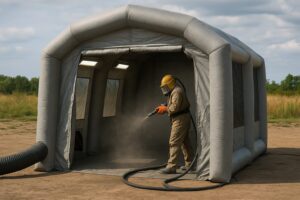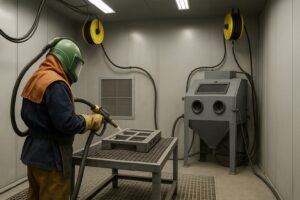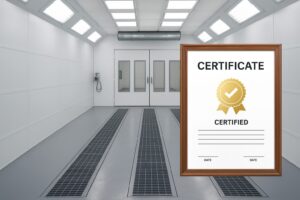Surface preparation is everything when it comes to a quality finish. Whether you’re painting automotive parts, fabricating steel, or preparing industrial machinery, one thing remains constant—blasting is where the magic begins. But achieving that perfect, uniform surface finish isn’t just about turning on the blaster and going at it. There’s a technique behind it, and when done right, it sets the stage for coatings that not only look great but also last longer.
It All Starts With the Right Media
The blasting media you choose is like your paintbrush. Just as you wouldn’t use a roller to paint fine details, you wouldn’t use heavy grit to prep a delicate surface. The key here is understanding the relationship between the surface material and the blasting media. Are you working with aluminum, steel, fiberglass, or wood? Each has different requirements.
For a uniform finish, the media needs to be consistent in size and type. Irregular or mixed media can result in patchy surfaces, with some areas more aggressively etched than others. That kind of inconsistency can show up even more dramatically once a coating is applied. Think of it like sanding a wall; if you skip a spot or use the wrong grit, it’s going to stand out once the paint hits it.
Glass beads, garnet, aluminum oxide, and steel shot are some of the most commonly used types. Each offers a different level of aggressiveness and texture. Matching your media to the substrate is step one in achieving that clean, uniform finish.
Keep a Steady Hand And a Steady Distance
Now let’s talk about technique. Blasting is a bit like painting or welding—consistency in hand movement makes a huge difference. One of the easiest ways to mess up a finish is by varying your distance from the surface. Too close, and you risk pitting or over-blasting; too far, and you don’t get the proper impact.
Maintaining a steady, even motion with consistent overlap is the secret sauce. You want about 50% overlap between passes, like mowing the lawn. This ensures that each part of the surface gets equal treatment, avoiding missed spots or hot spots. Think of it as gently erasing the old layer of imperfections without digging too deep in any one place.
Also, keep your nozzle angle in check. A 90-degree angle is the most efficient and uniform, unless you’re dealing with complex shapes where a slight angle helps access tough spots. But even then, avoid extremes. Extreme angles reduce impact energy and can cause an uneven blast profile.
Surface Cleanliness Is a Must
Uniformity isn’t just about texture, it’s also about cleanliness. Before blasting, the surface should be free of oil, grease, or heavy dirt. These contaminants not only mess with the blast pattern but can also cause media to clump or bounce inconsistently. Imagine trying to write on a greasy window with a marker—the results won’t be smooth, and they definitely won’t last.
Likewise, moisture in the air supply can cause media to clump inside the hose or blast pot, leading to sputtering and uneven output. That’s why using a dry, well-filtered air system is so important. Even the best operator can’t achieve a consistent finish if the equipment is working against them.
Use Well-Maintained Equipment
It may sound obvious, but equipment health plays a massive role in the final finish. A worn-out nozzle with an uneven tip can cause the blast pattern to fan out irregularly. Clogged hoses, leaky valves, or poor pressure regulation can all result in an inconsistent media flow.
Even your air compressor plays a role. Inconsistent air pressure equals inconsistent results. If your system drops pressure every time you trigger the nozzle, you’ll start seeing variations in surface texture. Regular maintenance, including inspections of nozzles, hoses, blast pots, and pressure settings, ensures everything flows smoothly—and that flow translates directly into uniformity.
Don’t Rush It
Blasting isn’t a race. One of the most common mistakes in the industry is rushing through the process to save time. Ironically, this usually leads to rework, which costs more time and money. A good, uniform finish takes patience.
It helps to follow a deliberate pattern—side to side, top to bottom—whatever works best for the part being blasted. Stick to your rhythm, keep your pace consistent, and resist the temptation to “touch up” one area more aggressively unless absolutely necessary. Uneven attention is how uneven finishes happen.
Inspect As You Go
Your eyes are your best tools. Even if everything seems to be going well, it’s smart to pause occasionally and inspect the surface. Natural lighting or a good shop light helps highlight texture inconsistencies before they become big problems. Run your hand over the surface—feel for rough patches or differences in texture. If you catch them early, a quick pass with the blaster can fix them before moving forward.
The idea is to treat blasting not as a background step but as part of the quality control process. The more you catch during blasting, the less likely you’ll face surprises during priming or painting.
It’s a Craft, Not Just a Task
Blasting might seem like a dirty, rough job and yes, it can be but there’s an art to doing it well. A uniform surface finish doesn’t happen by accident. It comes from choosing the right tools, paying attention to technique, and treating every project like it matters—because it does.
Blasting is the unsung hero in the world of paint booths and finishing systems. When done right, it ensures adhesion, smoothness, and the longevity of every coating that comes afterward. Skipping steps, cutting corners, or underestimating its importance only leads to one result: coatings that fail too soon.
Specialized Sandblasting Booth Services
We specialize in providing top-quality sandblasting booths and custom finishing solutions tailored to meet the unique needs of various industries. Our expert team designs and manufactures state-of-the-art sandblasting booths that ensure safety, efficiency, and superior performance. From automotive and aerospace to marine and industrial applications, our booths are engineered to handle even the most demanding surface preparation tasks. We offer comprehensive services, including booth installation, maintenance, upgrades, and technical support.




